Who is known as the Father of the constitution of India?
Bharat Ratna Baba Saheb Dr. Bhimrao Ambedkar is known as the Father of the constitution of India. He is also known as a ‘Modern Manu’.
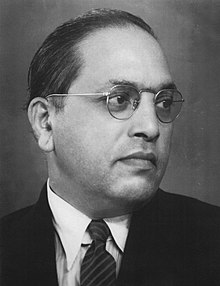
The salutation Jai Bhim used by followers honors him.
He is also referred to by the honorific Babasaheb meaning “Respected Father”.
B. R Ambedkar : A Biography , Ambedkar’s India
Why Dr. B R Ambedkar is known as the Father of the constitution of India?
Upon India’s independence on 15 August 1947, the new prime minister Jawaharlal Nehru invited Ambedkar to serve as the Dominion of India’s Law Minister; two weeks later, he was appointed Chairman of the Drafting Committee of the Constitution for the future Republic of India.
Dr B R Ambedkar headed the committee drafting the Constitution of India. Read also Making of Indian Constitution in detail.
The Constitution was adopted on 26 November 1949 by the Constituent Assembly.
Study Notes on Indian Constitution
- Fundamental Rights in Indian Constitution
- Indian Constitution and Civil Rights for University Assistant| Expected Questions Indian Constitution Kerala PSC
- 25 Parts of Indian Constitution Trick to Remember Download pdf
- 50 Expected questions on Indian Constitution for Peon Attender Exam Kerala PSC
- The Borrowed features of Indian Constitution from 10 Countries |My Notebook
- Indian Constitution Questions and Answers for Competitive Exams
- 20 Expected questions from Indian Constitution – Set 1
- Making of Indian Constitution in detail
- Indian Constitution Quiz 1|University Assistant Mock Test #3
- Father of Indian Constitution: Dr B. R Ambedkar
- ഇന്ത്യൻ ഭരണഘടന ആമുഖം Preamble of Indian Constitution
- ഭരണഘടന ചോദ്യോത്തരങ്ങൾ Indian Constitution Q&A
- ഇന്ത്യൻ രാഷ്ട്രപതി Indian President|ഇന്ത്യന് രാഷ്ട്രപതിമാര് psc
- ഇന്ത്യൻ ഭരണഘടന ഉപപ്രധാനമന്ത്രി- Indian Deputy Prime Minister
- ഇന്ത്യൻ ഭരണഘടന ഭരണഘടനാ ഭേദഗതികൾ Constitutional Amendments
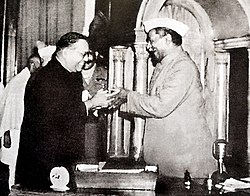
Dr. B. R Ambedkar
Bhimrao Ramji Ambedkar (14 April 1891 – 6 December 1956) was an Indian jurist, economist, social reformer, and political leader who headed the committee drafting the Constitution of India from the Constituent Assembly debates.
Dr. B R Ambedkar served as Law and Justice minister in the first cabinet of Jawaharlal Nehru
Dr. B R Ambedkar’s Study and Career
Dr. B R Ambedkar graduated from Elphinstone College, University of Bombay, and studied economics at Columbia University and the London School of Economics, receiving doctorates in 1927 and 1923 respectively
He also trained in the law at Gray’s Inn, London.
In his early career, he was an economist, professor, and lawyer.
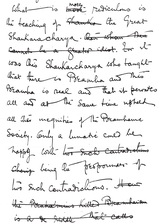
His later life was marked by his political activities; he became involved in campaigning and negotiations for India’s independence, publishing journals, advocating political rights and social freedom for Dalits, and contributing significantly to the establishment of the state of India.
In 1956, he converted to Buddhism, initiating mass conversions of Dalits.
Awards and Honors Dr B R Ambedkar
In 1990, the Bharat Ratna, India’s highest civilian award, was posthumously conferred on Ambedkar.
The salutation Jai Bhim used by followers honors him. He is also referred to by the honorific Babasaheb meaning “Respected Father.
In 1990, Dr. B.R. Ambedkar, the chief architect of our Constitution, was bestowed with Bharat Ratna.
The same year Dr. Ambedkar’s life-size portrait was also unveiled in the Central Hall of Parliament.
Dr. Babasaheb Ambedkar International Airport
Dr. Babasaheb Ambedkar International Airport in Nagpur, otherwise known as Sonegaon Airport.
NIT Jalandhar and Ambedkar University Delhi
Dr. B. R. Ambedkar National Institute of Technology, Jalandhar, Ambedkar University Delhi is also named in his honour
The Maharashtra government has acquired a house in London where Ambedkar lived during his days as a student in the 1920s. The house is expected to be converted into a museum-cum-memorial to Ambedkar.
voted as “the Greatest Indian”
Ambedkar was voted “the Greatest Indian” in 2012 by a poll organized by History TV18 and CNN IBN, ahead of Patel and Nehru.
Honors as an Economist
Due to his role in economics, Narendra Jadhav, a notable Indian economist, has said that Ambedkar was “the highest educated Indian economist of all times.“
Amartya Sen, said that Ambedkar is the “father of my economics”, and “he was highly controversial figure in his home country, though it was not the reality. His contribution in the field of economics is marvelous and will be remembered forever.”
Statue of B R Ambedkar
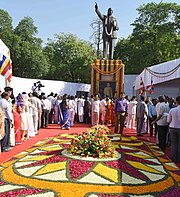
On 2 April 1967, an 3.66 metre (12 foot) tall bronze statue of Ambedkar was installed in the Parliament of India.
The statue, sculpted by B.V. Wagh, was unveiled by the then President of India, Sarvepalli Radhakrishnan
portrait of Dr. B.R. Ambedkar
On 12 April 1990, a portrait of Dr. B.R. Ambedkar is put in the Central Hall of Parliament House.
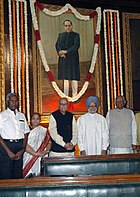
The portrait of Ambedkar, painted by Zeba Amrohawi, was unveiled by the then Prime Minister of India, V. P. Singh.
Another portrait of Ambedkar is put in the Parliamentary Museum and archives of the Parliament House.
Ambedkar Memorial
The Ambedkar Memorial at Lucknow is dedicated to his memory.
Chaitya Bhoomi
Chaitya Bhoomi is a Buddhist chaitya and the cremation place of B. R. Ambedkar, the chief architect of the Indian Constitution.
It is situated beside Dadar Chowpatty (beach), Mumbai
Drafting of the Indian Constitution
Upon India’s independence on 15 August 1947, the new prime minister Jawaharlal Nehru invited Ambedkar to serve as the Dominion of India’s Law Minister; two weeks later, he was appointed Chairman of the Drafting Committee of the Constitution for the future Republic of India.
On 25 November 1949, Ambedkar in his concluding speech in the constituent assembly said:-
“The credit that is given to me does not really belong to me. It belongs partly to Sir B.N. Rau the Constitutional Advisor to the Constituent Assembly who prepared a rough draft of the Constitution for the consideration of the Drafting Committee”.
Indian constitution significance
Indian constitution guarantees and protections for a wide range of civil liberties for individual citizens, including freedom of religion, the abolition of untouchability, and the outlawing of all forms of discrimination.
Ambedkar argued for extensive economic and social rights for women and won the Assembly’s support for introducing a system of reservations of jobs in the civil services, schools and colleges for members of scheduled castes and scheduled tribes and Other Backward Class.
The Constitution was adopted on 26 November 1949 by the Constituent Assembly.
Poona Pact
On 24th September 1932, Dr. Ambedkar and Gandhiji reached an understanding, which became the famous Poona Pact.
According to this Pact, in addition to the agreement on electoral constituencies, reservations were provided for untouchables in Government jobs and legislative assemblies.
The provision of a separate electorate was dispensed with.
The Pact carved out a clear and definite position for the downtrodden on the political scene of the country.
It opened up opportunities of education and government service for them and also gave them a right to vote.
Round Table Conferences in London
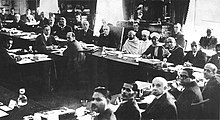
Dr. Ambedkar attended all three Round Table Conferences in London and each time, forcefully projected his views in the interest of the ‘untouchable’.
He exhorted the downtrodden sections to raise their living standards and to acquire as much political power as possible.
He was of the view that there was no future for untouchables in the Hindu religion and they should change their religion if need be. In 1935, he publicly proclaimed,” I was born a Hindu because I had no control over this but I shall not die a Hindu”
Independent Labour Party
After a while Dr. Ambedkar, organised the Independent Labour Party, participated in the provincial elections and was elected to the Bombay Legislative Assembly.
During these days he stressed the need for abolition of the ‘Jagirdari’ system, pleaded for workers’ Fight to strike and addressed a large number of meetings and conferences in Bombay Presidency.
In 1939, during the Second World War, he called upon Indians to join the Army in large numbers to defeat Nazism, which he said, was another name for Fascism.
B R Amdekar as Law Minister
In 1947, when India became independent, the first Prime Minister Pt. Jawaharlal Nehru, invited Dr. Ambedkar, who had been elected as a Member of the Constituent Assembly from Bengal, to join his Cabinet as a Law Minister.
Dr. Ambedkar had differences of opinion with the Government over the Hindu Code Bill, which led to his resignation as Law Minister.
The Constituent Assembly entrusted the job of drafting the Constitution to a committee and Dr. Ambedkar was elected as Chairman of this Drafting Committee.
While he was busy with drafting the Constitution, India faced several crises. The country saw partition and Mahatma Gandhi was assassinated.
In the beginning of 1948, Dr. Ambedkar completed the draft of the Constitution and presented it in the Constituent Assembly.
In November 1949, this draft was adopted with very few amendments. Many provisions have been made in the Constitution to ensure social justice for scheduled castes, scheduled tribes and backward classes.
Dr. Ambedkar was of the opinion that traditional religious values should be given up and new ideas adopted. He laid special emphasis on dignity, unity, freedom, and rights for all citizens as enshrined in the Constitution.
Ambedkar advocated democracy in every field: social, economic and political. For him, social Justice meant maximum happiness to the maximum number of people.
Dr Ambedkar and Budhism
On 24 May 1956, on the occasion of Buddha Jayanti, he declared in Bombay, that he would adopt Buddhism in October.
On 0ctober 14, 1956 he embraced Buddhism along with many of his followers. The same year he completed his last writing ‘Buddha and His Dharma’.
Dr. Ambedkar’s patriotism started with the upliftment of the downtrodden and the poor. He fought for their equality and rights.
His ideas about patriotism were not only confined to the abolition of colonialism, but he also wanted freedom for every individual. For him freedom without equality, democracy and equality without freedom could lead to absolute dictatorship.
Mahaparinirvan
On 6th December 1956, Baba Saheb Dr. B.R. Ambedkar attained ‘Mahaparinirvan‘.
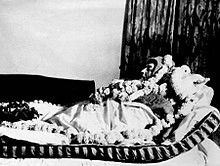
6th December is Mahaparinirvan Diwas now.
In 1990, Dr. B.R. Ambedkar, the chief architect of our Constitution, was bestowed with Bharat Ratna.
The same year Dr. Ambedkar’s life size portrait was also unveiled in the Central Hall of Parliament.
Year of Social Justice
The period from 14th April 1990-14th April 1991 was observed as ‘Year of Social Justice’ in the memory of Babasaheb, the champion of the poor and the downtrodden.
The Education Department, Government of Maharashtra (Mumbai) published the collection of Ambedkar’s writings and speeches in different volumes.
Works of Dr B R Ambedkar
Dr. B. R. Ambedkar’s best books
- Castes in India: Their Mechanism, Genesis and Development and 11 Other Essays
- Ambedkar in the Bombay Legislature, with the Simon Commission and at the Round Table Conferences, 1927–1939
- Philosophy of Hinduism; India and the Pre-requisites of Communism; Revolution and Counter-revolution; Buddha or Karl Marx
- Riddles in Hinduism ISBN 978-81-89059-77-4
- Essays on Untouchables and Untouchability
- The Evolution of Provincial Finance in British India
- The Untouchables Who Were They And Why They Became Untouchables ?
- The Annihilation of Caste (1936)
- Who Were the Shudras? (1946)
- Pakistan or the Partition of India
- What Congress and Gandhi have done to the Untouchables; Mr. Gandhi and the Emancipation of the Untouchables
- Ambedkar as member of the Governor General’s Executive Council, 1942–46
- The Buddha and his Dhamma
- Unpublished Writings; Ancient Indian Commerce; Notes on laws; Waiting for a Visa ; Miscellaneous notes, etc.
- Ambedkar as the principal architect of the Constitution of India
- (2 parts) Dr. Ambedkar and The Hindu Code Bill
- Ambedkar as Free India’s First Law Minister and Member of Opposition in Indian Parliament (1947–1956)
- The Pali Grammar
- Ambedkar and his Egalitarian Revolution – Struggle for Human Rights.
Ambedkar was trained as an economist, and was a professional economist until 1921, when he became a political leader. He wrote three scholarly books on economics:
- Administration and Finance of the East India Company
- The Evolution of Provincial Finance in British India
- The Problem of the Rupee: Its Origin and Its Solution[79][80]
- The Reserve Bank of India (RBI), was based on the ideas that Ambedkar presented to the Hilton Young Commission
Life of Dr Bhimrao Ambedkar
Dr.Bhimrao Ambedkar was born on 14th April, 1891 in Mahu Cantt in Madhya Pradesh. He was the fourteenth child of his parents.
The life of Dr. Bhimrao Ambedkar was marked by struggles but he proved that every hurdle in life can be surmounted with talent and firm determination.
The biggest barrier in his life was the caste system adopted by the Hindu society according to which the family he was born in was considered ‘untouchable’.
In the year 1908, young Bhimrao passed the Matriculation examination from Bombay University with flying colours.
Four years later he graduated in Political Science and Economics from Bombay University and got a job in Baroda. Around the same time his father passed away.
Although he was going through a bad time, Bhimrao decided to accept the opportunity to go to USA for further studies at Columbia University for which he was awarded a scholarship by the Maharaja of Baroda. Bhimrao remained abroad from 1913 to 1917 and again from 1920 to 1923.
During this period he had established himself as an eminent intellectual. Columbia University had awarded him the PhD for his thesis, which was later published in a book form under the title “The Evolution of Provincial Finance in British India.
His first published article was “Castes in India – Their Mechanism, Genesis and Development”.
During his sojourn in London from 1920 to 1923, he also completed his thesis titled “The Problem of the Rupee” for which he was awarded the degree of DSc.
Before his departure for London he had taught at a College in Bombay and also brought out Marathi weekly whose title was ‘Mook Nayak’ (meaning ‘Dumb Hero’).
By the time he returned to India in April 1923, Dr Bhimrao Ambedkar had equipped himself fully to wage war against the practice of untouchability on behalf of the untouchable and the downtrodden.
Meanwhile, the political situation in India had undergone substantial changes and the freedom struggle in the country had made significant progress.
While Bhimrao was an ardent patriot on one hand, he was the savior of the oppressed, women and poor on the other.
He fought for them throughout his life. In 1923, he set up the ‘Bahishkrit Hitkarini Sabha’ (Outcastes Welfare Association), which was devoted to spreading education and culture amongst the downtrodden, improving their economic status and raising matters concerning their problems in the proper forums to focus attention on them and finding solutions to the same.
The problems of the downtrodden were centuries old and difficult to overcome. Their entry into temples was forbidden.
They could not draw water from public wells and ponds. Their admission in schools was prohibited.
In 1927, he led the Mahad March at the Chowdar Tank at Colaba, near Bombay, to give the untouchables the right to draw water from the public tank where he burnt copies of the ‘Manusmriti’ publicly.
This marked the beginning of the anti-caste and ant-priest movement. The temple entry movement launched by Dr. Ambedkar in 1930 at Kalaram temple, Nasik is another landmark in the struggle for human rights and social justice.
In the meantime, Ramsay McDonald announced the ‘Communal Award’ as a result of which in several communities including the ‘depressed classes’ were given the right to have separate electorates.
This was a part of the overall design of the British to divide and rule. Gandhiji wanted to defeat this design and went on a fast unto death to oppose it.
On 24th September 1932, Dr. Ambedkar and Gandhiji reached an understanding, which became the famous Poona Pact.
- [PDF] Syllabus HST Hindi|134/2025 syllabus Kerala PSC
- [PDF]Syllabus HST Physical Science| 145,146/2025 syllabus Kerala PSC
- [PDF]Syllabus Deputy Finance Manager COIRFED|284/2024, 285/2024 syllabus Kerala PSC
- [PDF]HSA Social Science Syllabus Kerala PSC
- [PDF]Fireman Syllabus KERAFED|430/2024 syllabus Kerala PSC
- Fundamental Rights in Indian Constitution
- Indian Constitution and Civil Rights for University Assistant| Expected Questions Indian Constitution Kerala PSC
- 25 Parts of Indian Constitution Trick to Remember Download pdf
- 50 Expected questions on Indian Constitution for Peon Attender Exam Kerala PSC
- The Borrowed features of Indian Constitution from 10 Countries |My Notebook
- Indian Constitution Questions and Answers for Competitive Exams
- 20 Expected questions from Indian Constitution – Set 1
- Making of Indian Constitution in detail
- Indian Constitution Quiz 1|University Assistant Mock Test #3
- Father of Indian Constitution: Dr B. R Ambedkar
- ഇന്ത്യൻ ഭരണഘടന ആമുഖം Preamble of Indian Constitution
- ഭരണഘടന ചോദ്യോത്തരങ്ങൾ Indian Constitution Q&A
- ഇന്ത്യൻ രാഷ്ട്രപതി Indian President|ഇന്ത്യന് രാഷ്ട്രപതിമാര് psc
- ഇന്ത്യൻ ഭരണഘടന ഉപപ്രധാനമന്ത്രി- Indian Deputy Prime Minister
- ഇന്ത്യൻ ഭരണഘടന ഭരണഘടനാ ഭേദഗതികൾ Constitutional Amendments
